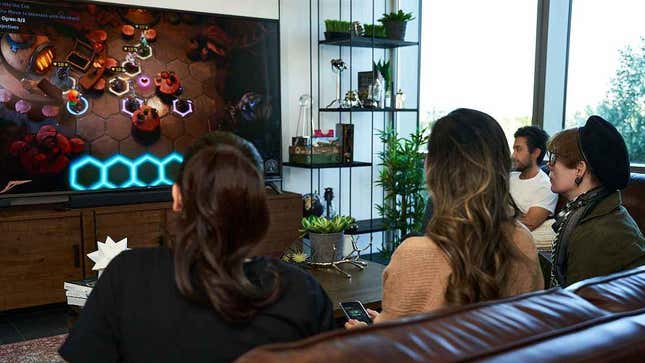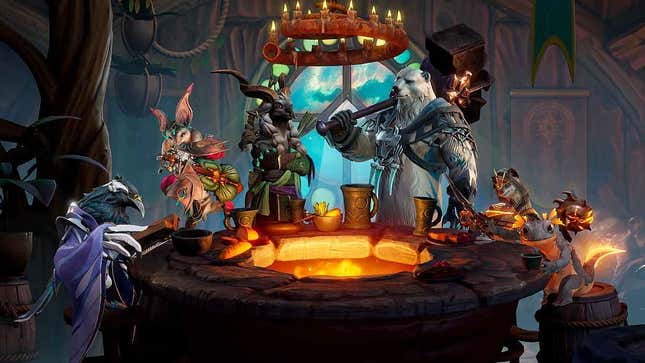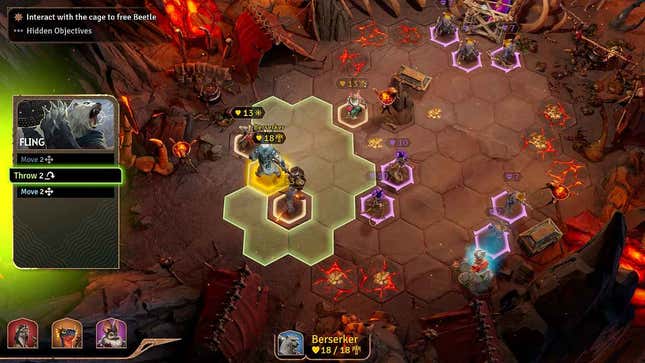Few things are harder than trying to get your friends into tabletop RPGs. The rules are complex, set up can be a pain in the ass, and you’ll need to carve out more than a couple of hours of time for a proper play session. Sunderfolk, the first video game from developer Secret Door—one of two studios under ex-Blizzard CEO Mike Morhaime’s company Dreamhaven—is hoping to make that barrier to entry a little lower.
It attempts to do that by mashing together the mechanical depth of board games like Gloomhaven with the easy pick-up-and-play nature of Jackbox, everybody’s favorite party game. After roughly two hours of hands-on time with an early build of Sunderfolk I can say that there is a lot to like in Secret Door’s experiment, but it might not be enough to leave your friends bitten by the board game bug.
Reinventing game night

“What if we could transform game night and make it more accessible to as many people as we possibly could,” studio head Chris Sigaty asks during the hands-on preview. Sagity, and many of the members of Dreamhaven and Secret Door, previously worked at Blizzard on competitive games like Starcraft II, Hearthstone, and Heroes of the Storm but the team wanted to do something new. “One of the things we realized up front was that we didn’t want to start with a competitive game,” he notes, “We wanted to focus on something that was really connective and collaborative.” To do this the team identified the three biggest barriers to entry into the board game scene: the steep learning curve, the time to set up, and the stigma that the hobby just isn’t for everybody.
While simplistic, “Jackbox meets Gloomhaven” is a pretty handy metaphor for what it’s like to play the two-screen experience of Sunderfolk. I sat down on a comfy couch alongside a couple other members of the press in a conference room with a big TV in front of us displaying Sunderfolk’s main screen. A member of Secret Door handed each of us an iPhone with the game’s companion app open and we dove into our adventure.
Upon release, which is slated for 2025, Sunderfolk will release on PC, PlayStation 5, Xbox Series X/S, and Nintendo Switch, with the mobile app being available on iOS and Android. All you need to do is scan a QR code to enter a game with friends. The game can be played online by streaming the main screen through Discord, but Secret Door really wants you to enjoy Sunderfolk as a couch co-op experience. Studio Head Chris Sigaty, and former Blizzard employee with credits as lead producer on StarCraft II, constantly stressed Sunderfolk’s overarching theme as being the “power of togetherness.”

Alongside up to three friends, you choose from six animal heroes, each of which is designed to communicate exactly how they’ll play. There’s the hulking polar bear who was unsurprisingly a tank-like hero, an intelligent and magic-wielding crow, and the musically inclined bat bard to name a few. The simple and evocative designs are a great way to indicate the intricacies of RPG classes for those who might not be so familiar with them. As for the world of Sunderfolk, it’s a pretty average fantasy setting. You and your band of adventures live in the city of Arden in the Sunderlands, an underground expanse that quickly is threatened by generic fantasy evil that you must stop.
Sunderfolk is made up of missions, and each mission begins with someparty discussion. Unlike TTRPGs such as D&D, there is no set order that determines who takes actions first—instead you and your friends will decide that during every single round of combat. While this is intended to allow for better strategizing on the part of the players, I found that it often led to awkward periods of not wanting to step on each other’s toes, though that could be a non-issue for a group made up of longtime friends. Once in combat, though, things really come together.
All the fun, and most of the drawbacks, of a good board game

Sunderfolk is, as you might expect, a turn-based tactical RPG. The map, composed of hexes, is displayed on the main screen while each player gets a little loadout of their available skills, items, etc. on their personal screen. Movement is done through the phone as well by drawing the path you want to on a smaller hex-grid with your finger. It’s a system that you’d think would be pretty finicky, but I was shocked to find it worked perfectly. Once it’s your turn you’ll choose a card to play, and each card is basically a skill. For example, my polar bear’s main card lets me move four spaces and then attack a single enemy next to me with a power of five. Another hero in my party could push enemies my way, allowing me to finish them off with my powerful attacks. The magic-wielding arcanist class summoned decoys that helped confuse the hordes of enemies I would rush into, keeping me from taking damage.
Each time you attempt an attack you’ll pull a fate card, Sunderfolk’s version of a D20, which will determine how successful your action is. You might get a -2 to your attack, or a +2, or a neutral card that grants you with a shield. Over the course of your playthrough you’ll collect different fate cards and customize your deck, which means your actions aren;t based solely on the pure luck associated with a D20. All of this is still quite a bit of rules and mechanics to stomach if you’ve never played a TTRPG before. I was able to get the gist of Sunderfolk pretty quickly thanks to a familiarity with its influences but I still needed a dev to help me out every so often during my playtime. In a normal setting, that job of teaching the rules will still fall on the friend with the most board game experience, which could get old, fast.

Working in tandem with other players quickly turned into a thrilling spectacle that felt right out of a TTRPG game night. The handful of missions I played were combat focused, but one did require more puzzle-solving, tasking me and my teammates with helping an NPC navigate a map filled with enemies. Mission variety still seems a little light in the two hours I experienced, but Secret Door teased that the game has other equipable weapons, boss battles, and more that I didn’t experience.
Between missions you’ll go back to the city of Arden, which acts as the game’s central hub. This is Sunderfolk’s “reprieve element” as game diretor Erin Marek puts it. “There’s always that moment when you’re playing board games when things have been really intense and you’re like ‘man, I just need to grab a snack.’” Marek continues, “That’s where the town idea formulated from.”
Here you’ll talk with a handful of NPCs to progress the story, shop for better equipment, upgrade the town, and more. In contrast to the rest of the game, which is done cooperatively, the town section lets you strike up conversations with NPCs individually, which is displayed on your phone. These will allow each player to build their own relationship with NPCs, some of which can lead to romance. In longer play sessions the mellow moments of in town might be more necessary as a short break, but in practice , these made the communal parts of Sunderfolk take the backseat, which is where the game works best.

While most of my short time with Sunderfolk was enjoyable I can’t help but think back on Sigaty’s words about their goal of bringing in newcomers to the board game hobby. While it does get rid of the lengthy setup for most TTRPGs, Sunderfolk still has some complex rules that require a time commitment to learn for the uninitiated, which is the biggest potential pain point for Sunderfolk. Secret Door said the game could take twenty hours minimum to complete its mostly linear campaign. Considering it is meant to be played in groups of four, that’s a handful of multi-hour sessions you’ll all need to lock in for, which is already the same thing keeping most people out of board games and TTRPGs in the first place.
My two hours with Sunderfolk didn’t successfully convince me that it’s a better entry into the hobby than just sitting your friends down with an actual board game. In its current state my biggest concern is that Sunderfolk will only find an audience in those who are already inducted into the hobby. That’s fine enough, but it isn’t what the team at Secret Door are setting out to do. Sigaty noted that a major hurdle to the hobby is that it isn’t for everyone. No matter how hard Secret Door tries, that might just be an unavoidable truth.
Sunderfolk is slated to release in 2025 on PC, PlayStation 5, Xbox Series X/S, and Nintendo Switch, with the mobile app being available on iOS and Android.
.




